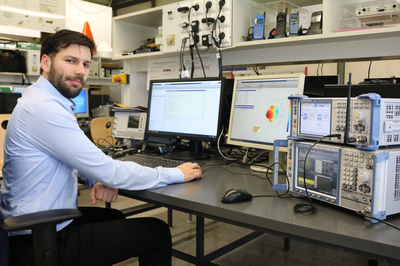Labor Telekommunikationstechnik / Wireless Communications
Telecommunication Engineering
Profile and objectives
The aim of the laboratory exercises is to deepen the theoretical content of the lectures in the corresponding subject area and to make it tangible through practical exercises. In addition, the laboratory offers the possibility of working on applied research projects as part of project work or final theses.
The Telecommunications Engineering Laboratory is offered to students of the Bachelor courses EI and EIplus of the Faculty of Electrical Engineering and Information Technology in the 6th or 7th semester, provided they have chosen the focus Communication Technology.
Furthermore, practical project exercises are offered for students of the Master's programme in Electrical Engineering and Information Technology (EIM) in the field of communication technology in the second semester as part of the course "Wireless Communications with Laboratory".
Equipment
In addition to a powerful computer network, the following essential devices and tools are available in this laboratory:
- R&S Digital Radio Tester CTS65 (GSM & DECT)
- R&S Communication Tester CMU 200 (Bluetooth)
- R&S Signal Analyzer FSV (7GHz)
- R&S Vector Signal Generator SMBV100A (6GHz)
- R&S ETH TV Analyzer (DVB-T)
- R&S RTO 1022 Oscilloscope (2GHz, 10 GSa/s)
- Fluke DSX-600 & Fluke OneTouch AT G2
- Ekahau Site Survey / Airopeek (WLAN Planning & Analysis Tools)
- xG-Planner / ChirPlus_M (GSM/UMTS radio network planning tools)
- Chipcon ZDK 420 Development / Evaluation Boards (ZigBee) with analysis tools Z-Trace, RF Studio, AVR Studio and Daintree Sensor Network
- Spectrum Analyzer Anritzu MS 2665C
- ARGUS 142 DSL Tester with ALL126AS2 & ALL126AM2 VDSL2 Modems
- various NovAtel SATNAV receivers ((D)GPS, Glonass, Galileo)
- Ettus Research Software Defined Radios USRP N210 & X300
Internships and tutorials
Practical exercises in the laboratory of Telecommunications Technology:
- Analysis of a LAN/WLAN network using the Fluke DSX-600 and OneTouch AT G2 meters
- Analysis of various methods for error protection coding (FEC)
- Digital display of information using pulse code modulation (PCM)
- Digital Modulation methods
- GSM radio network planning
- Metrological analysis of a satellite navigation system
- Metrological analysis of mobile communication terminals
- Metrological analysis of line coding methods
- xDSL transmission method
Practical exercises in the laboratory of Wireless Communications:
- Planning and analysis of a WLAN according to IEEE802.11
- Short distance communication according to the Bluetooth standard
- Test and analysis of the radio standard IEEE802.15.4 (ZigBee)
- Metrological analysis of digital carrier modulation signals
- Real-time location with Ultra-Wideband (UWB) radio signals
- Software Defined Radio
